On October, 2012, Boardwalk Pipeline Partners, LP (BWP) reported results of operations for 3Q 2012. Revenues, operating income, net income and earnings before interest, depreciation and amortization and income tax expenses (EBITDA) for 3Q12, 3Q11 and for the trailing 12 months (“TTM”) are summarized in Table 1: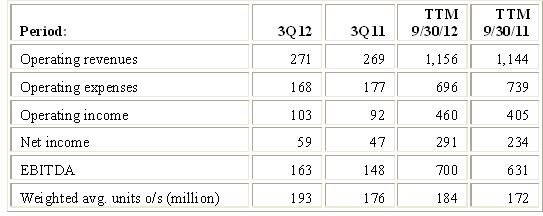
Table 1: Figures in $ Millions, except weighted average units outstanding
In February 2012, BWP acquired from Loews Corporation (L), the parent of BWP’s general partner, the remaining 80% equity interest in Boardwalk HP Storage Company, LLC for $285 million. . Boardwalk HP Storage operates seven high deliverability salt dome natural gas storage caverns in Forrest County, Mississippi, having approximately 29 billion cubic feet (“Bcf”) of total storage capacity, of which approximately 19 Bcf is working gas capacity. It also owns undeveloped land suitable for up to six additional storage caverns. Boardwalk HP Storage contributed ~$37 million of revenues to the TTM ended 9/30/12 (its results for the nine months period ended 9/30/12 are included as if the acquisition had occurred on 1/1/2012). Revenues from parking and lending (“PAL”) services and from firm transportation contracts also increased. But overall revenue growth was minimal due to the offsetting effects of lower natural gas prices on fuel retained in kind (as payment for transportation services) and of lower interruptible transportation service revenues due to a decrease in basis spreads between locations on the pipelines. See Glossary of MLP Operational Terms for a brief description of what are firm and interruptible transportation services, and of PAL.
Despite $21.4 million of expenses incurred by HP Storage and asset impairment charges, operating expenses in the TTM ended 9/30/12 were lower than the prior year period. The primary drivers of the decrease were lower fuel costs (due to lower natural gas prices) and lower administrative and general costs. In addition, the favorable comparison to the prior year is significantly aided by larger than normal expenses in 2011 (due, for example, to materials & supply impairment charges and charges related to a fire at a compressor station).
BWP’s definition of Distributable Cash Flow (“DCF”) and a comparison to definitions used by other master limited partnerships (“MLPs”) are described in a prior article. Using that definition, DCF for the TTM period ending 9/30/12 was $483 million ($2.62 per unit), up from $387 million in the comparable prior year period ($2.26 per unit).
As always, I first attempt to assess how these DCF figures compare with what I call sustainable DCF for these periods and whether distributions were funded by additional debt or issuing additional units. Given quarterly fluctuations in revenues, working capital needs and other items, it makes sense to review TTM numbers rather than quarterly numbers for the purpose of analyzing changes in reported and sustainable distributable cash flows.
The generic reasons why DCF as reported by the MLP may differ from sustainable DCF are reviewed in an article titled Estimating Sustainable DCF-Why and How. Applying the method described there to BWP results through 3Q 2012 generates the comparison outlined in Table 2 below: 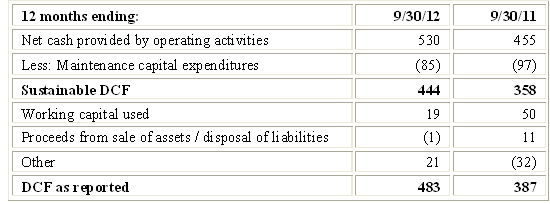
Table 2: Figures in $ Millions
Under BWP’s definition, reported DCF always excludes working capital changes, whether positive or negative. In contrast, as detailed in my prior articles, I generally do not include working capital generated in the definition of sustainable DCF but I do deduct working capital invested (this accounts for $19 million and $50 million of the variance between reported and sustainable DCF in the TTM ended 9/30/12 and 9/30/11, respectively). Despite appearing to be inconsistent, this makes sense because in order to meet my definition of sustainability the master limited partnerships should, on the one hand, generate enough capital to cover normal working capital needs. On the other hand, cash generated from working capital is not a sustainable source and I therefore ignore it. Over reasonably lengthy measurement periods, working capital generated tends to be offset by needs to invest in working capital. I therefore do not add working capital consumed to net cash provided by operating activities in deriving sustainable DCF. Similarly, I also do not add back into DCF items I do not regard as sustainable, such as proceeds from asset sales. The principal components of “other”, which I exclude from the sustainable category, are non-cash interest expense and proceeds from an insurance settlement.
Coverage ratios for 3Q 2012 are indicated in Table3 below: 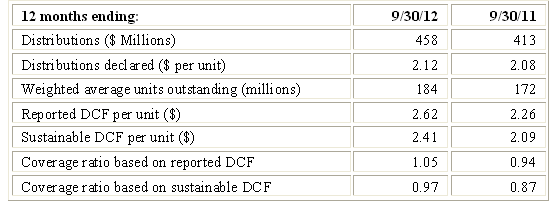
Even though distributions are not growing, coverage ratios are thin. Making them more robust will be challenging given that over 32 million units have been issued in three separate equity offerings so far in 2012 and that the number of units outstanding now exceeds 207 million, up ~12% from ~185 million at the beginning of the year.
The simplified cash flow statement in Table 4 below nets certain items (e.g., debt incurred vs. repaid), separates cash generation from cash consumption, and gives a clear picture of how distributions have been funded in the last two years. 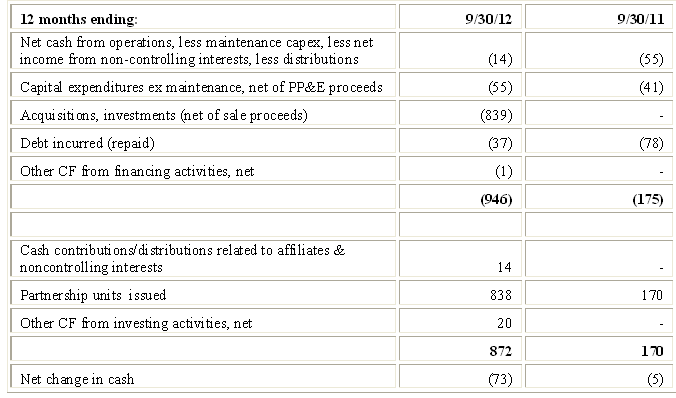
Net cash from operations less maintenance capital expenditures did not cover distributions in both TTM periods (the shortfall decreased to $14 million in the TTM ending 9/30/12 from $55 million in the prior year period). Table 3 therefore shows that distributions in both TTM periods were partially financed by issuing equity.
Note that ~ $282 million of the $838 million of equity issuance in the TTM ended 9/30/12 is an adjustment to partners’ capital. In February 2012, The Boardwalk HP Storage Company drop-down acquisition was accounted for as a transaction between entities under common control. Therefore, the assets and liabilities of Boardwalk HP Storage were recognized at their carrying amounts at the date of transfer and $281.8 million (the carrying amount of the net assets acquired) was treated as an adjustment to partners’ capital.
In February 2012, BWP issued 9.2 million units at $27.55 per unit, receiving net cash proceeds of ~$250.2 million. In an article dated 6/4/12, I said I would not be surprised to see additional partnership units being issued later this year. Indeed, in August BWP issued 11.6 million units at $27.80 per unit generating net proceeds of ~$318 million; and in October 2012 it issued 11.2 million units at $26.99 per unit generating net proceeds of ~$298 million. The most recent equity issuance was in connection with a major transaction that occurred subsequent to the end of the third quarter. In October 2012, BWP took a major step in implementing its strategy to diversify from its core business (natural gas pipelines and storage) into the midstream energy businesses by acquiring PL Midstream LLC (now renamed Boardwalk Louisiana Midstream) from PL Logistics LLC for $625 million in cash. Boardwalk Louisiana Midstream provides ~53.5 million barrels of salt-dome storage capacity, 240 miles of pipeline transportation, fractionation and brine supply services for producers and consumers of petrochemicals, natural gas liquids and natural gas. BWP intends to spend an additional $75 million on expansion projects related to this acquisition.
BWP’s major organic growth project is the Southeast Market Expansion. This ~$300 million project involves constructing an interconnection between BWP’s Gulf South Pipeline Company, LP (Gulf South) and Boardwalk HP Storage, adding additional compression facilities and constructing approximately 70 miles of 24” and 30” pipeline in southeastern Mississippi. It
is expected to be placed in service in 4Q 2014 and is fully contracted with a weighted average contract life of ~10 years.
BWP is required to maintain a ratio of consolidated debt to EBITDA of no more than 5:1. Excluding the $100 million of affiliated debt, BWP’s total long-term debt stood at $3.2 billion as of 9/30/12, a multiple of 4.52x EBITDA for the TTM ending 9/30/12. This is an improvement over the 5x ratio in 2Q12 and ~5.5x in 1Q12. There is room for additional debt to finance the remaining ~$116 million of growth capital expenditures planned for 2012 (~$84 million has been spent through 9/30/12).
BWP’s current yield compares favorably with many of the other MLPs I follow, as seen in Table 5 below: 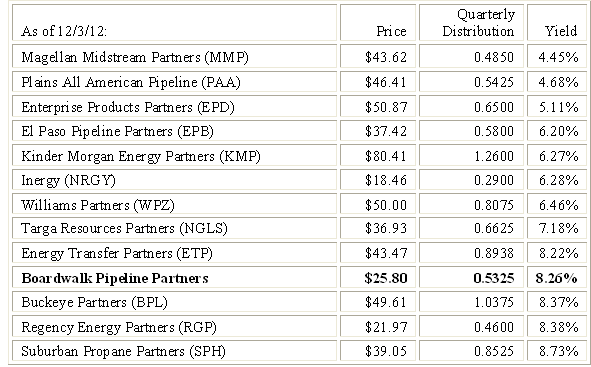
However, there has been minimal distribution growth over the TTM ending 9/30/12. Given uncertainty regarding customer contract renewals and its assessment of current market conditions, management decided it would not be prudent to increase distributions. I believe this is a sound decision. But even at their current level, distributions are being funded, in part, by issuing equity. Adding the thin coverage ratio and relatively high leverage to this concern, I still conclude that investors willing to add to their positions should consider other MLPs.
- English (UK)
- English (India)
- English (Canada)
- English (Australia)
- English (South Africa)
- English (Philippines)
- English (Nigeria)
- Deutsch
- Español (España)
- Español (México)
- Français
- Italiano
- Nederlands
- Português (Portugal)
- Polski
- Português (Brasil)
- Русский
- Türkçe
- العربية
- Ελληνικά
- Svenska
- Suomi
- עברית
- 日本語
- 한국어
- 简体中文
- 繁體中文
- Bahasa Indonesia
- Bahasa Melayu
- ไทย
- Tiếng Việt
- हिंदी
Boardwalk Pipeline Partners’ Distributable Cash Flow
Published 12/05/2012, 10:50 AM
Updated 07/09/2023, 06:31 AM
Boardwalk Pipeline Partners’ Distributable Cash Flow
3rd party Ad. Not an offer or recommendation by Investing.com. See disclosure here or
remove ads
.
Latest comments
Install Our App
Risk Disclosure: Trading in financial instruments and/or cryptocurrencies involves high risks including the risk of losing some, or all, of your investment amount, and may not be suitable for all investors. Prices of cryptocurrencies are extremely volatile and may be affected by external factors such as financial, regulatory or political events. Trading on margin increases the financial risks.
Before deciding to trade in financial instrument or cryptocurrencies you should be fully informed of the risks and costs associated with trading the financial markets, carefully consider your investment objectives, level of experience, and risk appetite, and seek professional advice where needed.
Fusion Media would like to remind you that the data contained in this website is not necessarily real-time nor accurate. The data and prices on the website are not necessarily provided by any market or exchange, but may be provided by market makers, and so prices may not be accurate and may differ from the actual price at any given market, meaning prices are indicative and not appropriate for trading purposes. Fusion Media and any provider of the data contained in this website will not accept liability for any loss or damage as a result of your trading, or your reliance on the information contained within this website.
It is prohibited to use, store, reproduce, display, modify, transmit or distribute the data contained in this website without the explicit prior written permission of Fusion Media and/or the data provider. All intellectual property rights are reserved by the providers and/or the exchange providing the data contained in this website.
Fusion Media may be compensated by the advertisers that appear on the website, based on your interaction with the advertisements or advertisers.
Before deciding to trade in financial instrument or cryptocurrencies you should be fully informed of the risks and costs associated with trading the financial markets, carefully consider your investment objectives, level of experience, and risk appetite, and seek professional advice where needed.
Fusion Media would like to remind you that the data contained in this website is not necessarily real-time nor accurate. The data and prices on the website are not necessarily provided by any market or exchange, but may be provided by market makers, and so prices may not be accurate and may differ from the actual price at any given market, meaning prices are indicative and not appropriate for trading purposes. Fusion Media and any provider of the data contained in this website will not accept liability for any loss or damage as a result of your trading, or your reliance on the information contained within this website.
It is prohibited to use, store, reproduce, display, modify, transmit or distribute the data contained in this website without the explicit prior written permission of Fusion Media and/or the data provider. All intellectual property rights are reserved by the providers and/or the exchange providing the data contained in this website.
Fusion Media may be compensated by the advertisers that appear on the website, based on your interaction with the advertisements or advertisers.
© 2007-2024 - Fusion Media Limited. All Rights Reserved.
